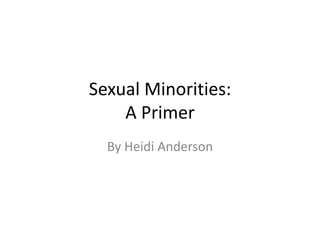
Working With Sexual Minorities
- 1. Sexual Minorities:A Primer By Heidi Anderson
- 2. What is a Sexual Minority? A sexual minority is a group whose sexual identity, orientation or practices differ from the majority of the surrounding society.
- 3. Sexual Orientation:Who Are They Attracted To? Heterosexuals are attracted to members of the opposite biological sex (straight) Homosexuals are attracted to members of the same biological sex (gay and lesbian) Bisexuals are attracted to members of both biological sexes (Bi) Pansexuals experience attraction to a person, without regard to biological sex, gender identification, or orientation (pan, omnisexual)
- 4. Biological Sex and Gender IdentityHow Does the Client Identify Biological sex refers to the biological characteristics of a person at birth, male or female Intersex people are born with aspects of both female and male genitalia, often referred to as “ambiguous biological sex characteristics.”
- 5. Biological Sex and Gender IdentityHow Does the Client Identify Gender identity is the sense of one’s self as male or female and does not refer to one’s sexual orientation. Transgender is a general term that is used by individuals that do not conform to the gender expectations of their biological sex. Transsexuals are people with the biological characteristics of one sex who identify themselves as the opposite gender and have had some type of surgical alteration and/or hormone treatments that changes their bodies’ appearance in alignment with their identity.
- 6. Biological Sex and Gender IdentityTransgender is Not: Cross dressers or transvestites wear clothes usually worn by people of the opposite biological sex. They do not, however, identify themselves as having a gender identity different from their biological sex or gender role. Drag queens (i.e., gay men who dress in female clothing) and female impersonators (who perform in clubs or cabarets) are not necessarily transgender individuals. The same is true of drag kings (i.e., women who dress in men’s clothing)
- 7. Sexual BehaviorsWhat Does Your Client Do Your Client is Not There to Satisfy Your Curiosity Do Not Make Assumptions Put Yourself in Their Shoes – Imagine Trying to Justify What Arouses YOU! While no more common in the LGBT world, BDSM (bondage, domination, sadism, masochism) is another type of non-mainstream behavior between consenting adults. This is NOT THE SAME THING AS ABUSE Some clients may have more than one lover, or even more than one committed partner, also called polyamory
- 8. What is Homophobia? Prejudice and discrimination against LGBT (lesbian, gay, bisexual, transgender) individuals formed, in part, by misinformation such as the following: • All gay men are effeminate, and all lesbians are masculine. • LGBT persons are child molesters. • LGBT individuals are unsuitable for professional responsibilities and positions. • LGBT persons cannot have fulfilling relationships. • LGBT persons are mentally ill.
- 9. Examples of Heterosexism • The lack of legal protection for individuals in employment and housing • The continuing ban on lesbian and gay military personnel • The hostility and lack of support for gay committed relationships • The enforcement of outdated sodomy laws that are applied to LGBT individuals but not applied to heterosexual individuals. • Gay-bashing conversations • Cynical remarks and jokes regarding gay sexual behaviors • Jokes about openly LGBT staff members • Lack of openly LGBT personnel • Lack of inclusion of LGBT individuals’ family members or significant others in treatment processes.
- 11. Focus on the Person, Not Assumed Sexual Behavior Richard Renaldi, 2005